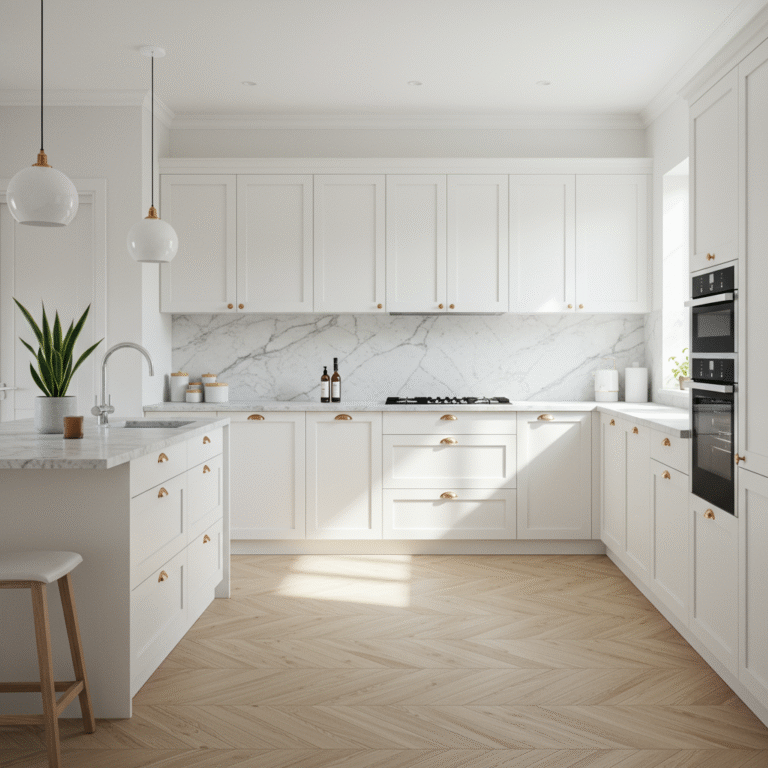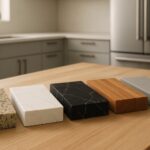A kitchen remodel can turn your home’s heart into a space that’s actually yours. The average kitchen remodel costs $71,159 for a medium-size kitchen and $137,228 for a large kitchen in 2025, though you might spend anywhere from $27,000 to $156,000 depending on your choices.
Knowing these costs up front helps you plan and sidestep those painful budget surprises.
Cabinet choices, countertop materials, labor, and where you live—these all shape your final price tag.
The scope matters too. A quick facelift with paint and fixtures is a whole different animal than ripping everything down to the studs.
Need a Home Fix – Emergency or Routine?
From leaks and no-heat nights to simple tune-ups, our 24/7 hotline connects you with trusted local pros in minutes.
If you plan smart and know where your money goes furthest, you can squeeze more value out of your budget.
Location matters more than people expect. California and Massachusetts? Usually pricier. Oklahoma and South Dakota? Much more affordable.
Understanding regional price swings helps you set expectations and avoid sticker shock.
Key Takeaways
- Kitchen remodels run from $27,000 to $156,000, depending on size and scope
- Cabinets, countertops, labor, and appliances eat up most of the budget
- Regional differences are real, and setting aside a 10-15% contingency fund is just smart planning
The Average Kitchen Remodeling Costs in 2025
Kitchen remodeling costs in 2025 bounce around a lot, depending on what you want and the quality you expect. The national average for a medium-size kitchen renovation sits at $71,159.
Bigger projects? You’re looking at $137,228 on average.
National Cost Ranges
Depending on the size and what you plan to tackle, kitchen remodels in 2025 can really swing in price. According to the National Kitchen & Bath Association’s 2025 Kitchen Trends Report, the average for a medium-size renovation is $71,159.
Large kitchen remodels jump up to $137,228. Most folks will spend somewhere between $27,000 and $156,000, though.
Where you live shifts the numbers. California, Massachusetts, Utah, Colorado, and Wyoming? People there usually pay the most.
If you’re in Oklahoma, Louisiana, Oregon, Ohio, or South Dakota, you’ll probably catch a break. Regional differences can swing your total by thousands.
Cost Breakdown by Remodel Type
Minor kitchen remodels usually cost around $27,600 and stick to surface updates. Think new appliances, countertops, floors, and maybe cabinet refinishing—no big structural changes.
Mid-range kitchen renovations average $25,000 to $30,000 for standard upgrades in a typical kitchen. You’ll replace main fixtures and maybe tweak the layout a bit.
Standard kitchen remodels run from $15,000 to $60,000. That’s where most projects land these days.
If your project needs plumbing or electrical work, expect to pay more than if you’re just freshening up the look.
Key Differences: Basic, Mid-Range, and Luxury Renovations
Basic kitchen renovations start at $15,000 and cover essentials like paint, new hardware, and basic appliances. It’s about function, not flash.
Mid-range kitchen remodels run between $25,000 and $71,159 for most people. You get better materials, pro installation, and some upgrades to cabinets and counters.
Luxury kitchen renovations can blow past $137,228, with high-end materials, custom cabinets, and fancy appliances. These projects often get into structural changes and designer finishes.
What separates these levels? Material quality, how custom you go, and the complexity of the work. High-end jobs need specialized contractors and take longer.
Major Cost Factors Impacting Your Kitchen Remodel
What really drives your kitchen remodel cost in 2025? Size, layout, scope, materials, and labor—all the usual suspects.
Kitchen Size and Layout
The bigger the kitchen, the bigger the bill. Small kitchens usually cost $15,000 to $35,000. Large ones? $50,000 to $150,000 or more.
Square footage matters. More space means more flooring, paint, lighting, cabinets, and counters. A 200-square-foot kitchen needs twice the stuff of a 100-square-foot one.
If you start moving plumbing, electrical, or gas lines, costs climb fast—usually $5,000 to $15,000 extra. Keeping your layout saves money on labor and permits.
Want an open concept? Removing walls means structural work, permits, and pros. You’ll probably double your labor costs compared to just updating finishes.
Adding or expanding an island? Running new plumbing or electrical to it adds $2,000 to $5,000.
Scope of the Remodel
How much you change affects your spend. Minor remodels stick to updates like paint, refacing cabinets, and swapping out hardware.
Three main categories:
- Minor remodels: $10,000 to $27,000
- Major midrange remodels: $40,000 to $80,000
- Luxury remodels: $80,000 to $158,000+
Cosmetic tweaks—like refacing cabinets for $1,700 to $5,200—often give the best bang for your buck. Custom cabinets? That’ll be $12,500 and up.
New paint and backsplash can run under $3,000 but make a huge visual difference.
Full gut jobs need permits, structural work, and brand-new everything. These take 6-12 weeks and sometimes reveal surprises that drive up costs.
Material Choices and Their Impact
Materials can make or break your budget. Cabinets and countertops alone range from $5,000 to $40,000, depending on what you pick.
Cabinet costs:
- Stock: $100-$300 per linear foot
- Semi-custom: $150-$650 per linear foot
- Custom: $500-$1,200 per linear foot
Countertops? Laminate is $20-$50 per square foot. Natural stone can hit $55-$320 per square foot.
Popular countertop choices:
- Granite: $55-$210 per square foot
- Quartz: $75-$160 per square foot
- Marble: $125-$320 per square foot
Appliance packages start around $6,000 for basics and can go up to $22,000 for smart, high-end models. Energy-efficient ones cost more up front but save you money over time.
Labor and Professional Fees
Labor eats up 40-50% of your kitchen remodel budget. You’re paying for quality work, but it’s a big chunk.
Typical labor costs:
- General contractor: 15-20% of total project
- Plumber: $50-$160 per hour
- Electrician: $75-$150 per hour
- Tile installer: $45-$85 per hour
Labor rates jumped 5-10% in 2025, thanks to inflation and demand. Urban areas usually charge 20-30% more than rural spots for the same work.
If your project needs multiple trades—like structural changes, custom millwork, or specialty installs—expect to pay a premium for skilled pros.
Permits tack on $100-$1,500. Most kitchen remodels need them for electrical, plumbing, or structural work. Contractors usually handle permits, but they’ll charge for it.
Cabinet Options and Associated Costs
Cabinets eat up 30-50% of your remodel budget. They’re the priciest part, hands down. You’ve got three main types: stock ($5,000-$20,000), semi-custom ($9,000-$35,000), and custom (over $35,000).
Stock Cabinets
Stock cabinets are pre-made and sold in standard sizes at big box stores. If you’re on a tight budget, these are your best bet.
They come in fixed sizes, usually in 3-inch jumps. Common widths are 12, 15, 18, 24, 30, and 36 inches.
Cost Range: $5,000-$20,000 for a full kitchen.
Stock cabinets use materials like particleboard or MDF, with basic laminate or wood finishes. You can install them in 1-2 weeks since they’re ready to go.
| Pros | Cons |
|---|---|
| Lowest cost option | Limited size options |
| Available immediately | Basic materials |
| DIY-friendly | Shorter lifespan |
Stock cabinets work best in standard kitchens without weird dimensions. They’re perfect for rentals or quick house flips where every dollar counts.
Semi-Custom Cabinets
Semi-custom cabinets give you more flexibility than stock, but don’t cost as much as custom. Manufacturers build them to order, letting you pick sizes and finishes.
You can get them in 1-inch increments to fit most layouts. There are plenty of wood species, stains, and hardware options.
Cost Range: $9,000-$35,000 for a full kitchen.
Semi-customs use better materials like solid wood frames and plywood boxes. You’ll wait 6-8 weeks for delivery after you order.
Popular woods are oak, maple, cherry, and birch. You can choose painted or stained finishes with different gloss levels.
Semi-custom works for people who want better quality than stock but don’t need the full custom treatment. Most kitchens fit this category.
Custom Cabinets
Custom cabinets are built just for your kitchen, with zero size limits. Local shops or specialty makers craft these unique pieces.
You control everything—dimensions, materials, finishes, and all the interior bells and whistles. You can get measurements down to the quarter-inch if you want.
Cost Range: $35,000+ for a complete kitchen.
Customs use top-notch materials like solid hardwood, rare woods, and premium hardware. Builders use dovetail joints and soft-close everything.
Expect to wait 8-16 weeks, depending on how complicated your order is. Some places can rush it in 5-10 business days, but that’s rare.
Premium Features:
- Exotic woods like walnut or rift oak
- Special storage solutions
- Built-in lighting
- Soft-close drawers and doors
Custom cabinets make sense for tricky layouts, luxury homes, or if you’ve got specific storage needs that off-the-shelf just can’t handle.
Countertops, Islands, and Lighting Choices
Kitchen countertops start at $30 per square foot for basic quartz and can climb to $200 or more for high-end marble. Kitchen islands run anywhere from $800 to $6,000, depending on how big and fancy you want to get.
Lighting usually eats up about 8% of the kitchen budget. Pendant lights kick off around $200 each, but you can go wild with pricier options if you want.
Laminate Countertops and Alternatives
If you’re looking to save, laminate countertops are the cheapest route. They’re way less expensive than stone and come in a surprising range of styles these days.
Still, a lot of folks upgrade for better durability and resale value. Quartz countertops start at $30 per square foot and can hit $250 for the fancier, more realistic options that look like natural stone.
Granite’s still hanging in there, even if some people think it’s out of style. Good granite costs $30 to $150 per square foot and holds up well since it’s real stone.
Marble brings that luxury vibe, but you’ll pay for it. Calacatta Viola marble can be $200 per square foot, while other marbles land in the $45 to $85 range.
Quartzite sits somewhere between quartz and marble in both price and look. It’s got unique veining and develops a patina, so every slab feels a bit special.
Adding or Upgrading a Kitchen Island
A kitchen island gives you extra workspace and storage—honestly, it’s hard to go back once you’ve had one. Prefab islands cost $800 to $2,500 if you don’t need fancy electrical or plumbing work.
Custom islands run $3,000 to $6,000, depending on what you want. You can get specific dimensions, built-in appliances, or clever storage.
Add outlets, seating, or a sink, and the costs jump. Just the electrical work can tack on another $500 to $1,500.
Bigger islands (over 8 feet) cost more than the smaller ones. No surprise there.
Island countertop materials follow the same price rules as the rest of your counters. Some people pick something different for the island just to mix things up visually.
Lighting: Pendant Lights and More
Lighting usually takes up about 8% of your kitchen reno budget, but that number moves around based on how fancy you get or how many fixtures you need.
Pendant lights are the go-to above islands and dining spots. Mid-range pendants cost $200 to $300 each, but custom stuff can hit $500 to $5,000 a pop.
Expect to pay $150 to $250 extra for installation per fixture. If you need new circuits or have old wiring, installation gets pricier.
Under-cabinet lighting is awesome for visibility and costs $100 to $300 per linear foot installed. LED strips last a long time and save energy, so they’re popular.
Recessed lights give you general illumination. Each one costs $75 to $200 installed, depending on what you pick and the electrical setup.
If you want a statement chandelier or track lighting, plan for a bigger budget. Sometimes you need a designer’s help to get the placement and size right.
Regional Price Variations and Permitting
Kitchen remodel costs jump around by 20% to 40% depending on where you live. Big cities usually mean higher prices. Permits add another $300 to $1,500—and that really depends on your city.
Location-Based Cost Differences
High-cost metro areas like DC and New York often see kitchen renos running 25% to 40% above the national average. Materials cost more to ship in, and labor’s pricier.
So, a $50,000 remodel elsewhere might be $60,000 or $70,000 in these cities. San Francisco and LA? Same story.
In cheaper regions like Houston or St. Louis, you can get more for your money. That same $50,000 job might cost $35,000 to $45,000.
Why such a gap?
- Material shipping costs go up in remote spots
- Labor supply and demand changes contractor rates
- Local building codes mean different compliance costs
- Cost of living affects everything
Rural areas sometimes struggle with finding contractors, which can push up labor costs even if base rates are lower.
Permit and Regulation Expenses
If you’re moving plumbing, adding electrical, or making structural changes, you’ll need permits. These usually cost $300 to $1,500, depending on the project and location.
Typical permit costs break down like this:
- Electrical: $100–$500
- Plumbing: $200–$800
- Structural: $300–$1,200
Some cities tack on inspection fees, often $50 to $150 per visit.
Meeting building codes bumps up labor costs, sometimes by 10% to 20%. Contractors have to make sure everything passes inspection, which can mean more time and money.
Strict cities require multiple inspections, and every one adds to your timeline—and your patience gets tested, too.
Smart Budgeting for Your 2025 Kitchen Remodel
Smart budgeting for a kitchen remodel really comes down to making choices that give you the most bang for your buck. Knowing when to splurge, when to save, and when to call in the pros makes all the difference.
Saving on Cabinets and Materials
Cabinets usually eat up 25% to 35% of the budget. If you want to save, stock cabinets are your friend—they start around $5,000 and come in standard sizes and popular looks.
Semi-custom cabinets cost $10,000 to $15,000 and give you a bit more flexibility. Go custom, and you could spend $25,000 or more.
Laminate countertops cost about $1,500, while quartz or granite runs $3,000 to $7,000. Modern laminate actually looks pretty sharp these days.
You can also save by picking:
- Tile flooring instead of hardwood
- Painted walls instead of tiled backsplashes
- Standard appliances over luxury brands
Shopping during sales can knock 10% to 20% off your materials bill. It pays to keep an eye out for deals.
DIY vs. Professional Remodeling
If you’re handy, doing some of the work yourself can save 20% to 30% on labor. Painting, swapping hardware, and demolition are usually safe bets.
But for stuff like:
- Electrical wiring
- Plumbing
- Gas lines
- Structural work
—just hire a pro.
DIY projects that make sense:
- Painting or refinishing cabinets
- Installing new cabinet doors
- Putting up a tile backsplash
- Replacing light fixtures
Messing up electrical or plumbing can get expensive fast. Most people save the most by handling prep and finishing touches themselves, then letting licensed contractors handle the tricky stuff.
Prioritizing High-Impact Upgrades
If you’re on a budget, spend where it counts. Cabinet updates make the biggest visual difference for the money.
High-impact changes:
- New cabinet doors and hardware
- Fresh countertops
- Modern lighting
- New paint
Lower-impact (and pricier) options:
- Fancy appliances
- Custom storage solutions
- Smart home gadgets
Honestly, a $2,000 cabinet refresh can look better than a $10,000 fridge. People notice cabinets and counters first.
Stick with your current layout if you can. Moving sinks or stoves means hiring pros and getting permits, which adds up fast.
Financing and Payment Strategies
Most contractors want 25% down before starting. As a rule of thumb, budget 5% to 15% of your home’s value for a kitchen remodel.
Popular ways to pay:
- Home equity loans (lower interest)
- Personal loans (quick approval)
- Credit cards (smaller jobs)
- Cash (no interest)
Some contractors offer financing deals that beat the banks. Always get a few quotes—prices can swing a lot.
Set aside an extra 10% to 20% for surprises. Older homes especially tend to hide problems that pop up once you start tearing things out.
Frequently Asked Questions
Kitchen remodel costs in 2025 are all over the map, depending on where you live, the size of your kitchen, and what’s hot in the market. Knowing the main factors makes planning a lot less stressful.
What factors influence the per square foot cost of a kitchen remodel in 2025?
Material choices and project scope drive the per square foot cost. Basic updates run $150 to $200 per square foot, while luxury projects can reach $400 to $500.
Cabinets have the biggest impact. Stock keeps things cheaper, but custom options push the price up fast.
Countertop material matters, too—laminate’s about $25 per square foot, but marble can hit $80 to $100.
If your remodel is mostly cosmetic, you’ll pay less per square foot than if you’re gutting the place and redoing electrical or plumbing.
How do regional differences within the USA affect kitchen remodeling costs in 2025?
Big cities like New York, LA, and San Francisco have costs 30% to 50% above the national average. Labor rates in these areas often top $100 an hour.
Rural spots usually have cheaper labor, but getting materials delivered can cost more. Sometimes, it’s also tough to even find a contractor.
The Southeast and Midwest are usually the most affordable. Permit fees and contractor prices are lower here.
Western states pay more for materials thanks to higher shipping costs. If you’re remote, supply chain hiccups can hit harder.
Are there online calculators that provide accurate kitchen remodel estimates for 2025?
Online calculators give ballpark figures, but they’re not super precise. They use national averages and don’t account for local quirks.
Contractor estimates are more accurate since they factor in local labor, permits, and material costs.
Some manufacturer sites have better tools for their products—cabinet and countertop companies, for example.
Use online calculators as a jumping-off point, but get multiple contractor quotes for real planning.
What is the average cost of a kitchen remodel for common sizes like 10×10 or 12×12 in 2025?
A mid-range 10×10 kitchen remodel runs $25,000 to $45,000. That gets you standard cabinets, laminate or quartz counters, and basic appliances.
Luxury versions of the same size can hit $60,000 to $80,000, with custom everything and high-end appliances.
A 12×12 kitchen remodel costs $35,000 to $65,000 for mid-range work. The bigger footprint means more cabinets and counters.
High-end 12×12 projects can reach $80,000 to $120,000, especially if you go for complex layouts and all the bells and whistles.
Can homeowners expect remodeling costs to decrease at any point in 2025?
Material costs will likely stay steady or creep up a bit through 2025. Lumber prices have finally calmed down, but other building materials just keep inching up with inflation.
Labor shortages are still a headache for the construction industry. Skilled trades are tough to book, and that keeps labor costs high in most places.
Supply chain snags aren’t the crisis they once were, though transportation costs haven’t really dropped back to what they were before 2020. That bumps up material prices a bit, but not like the wild swings we saw a couple years ago.
Winter might offer a tiny break—some contractors drop their rates during the slow season. Still, don’t expect huge savings; it’s usually just a modest discount.
What design trends are driving kitchen remodel costs in 2025?
Smart home technology integration tacks on anywhere from $3,000 to $8,000 to a renovation budget. More and more homeowners want connected appliances—plus automated lighting systems just seem to be on everyone’s wishlist these days.
Large kitchen islands with specialty features can really bump up costs. When you add things like built-in wine storage, prep sinks, or charging stations, you’re paying extra for both materials and labor.
Two-tone cabinet designs look great, but they require more complex installation and finishing work. Even if you stick with the same cabinet quality, this trend still drives up labor costs.
Sustainable materials such as recycled countertops or eco-friendly finishes tend to cost 15-25% more than the usual options. Still, green building materials keep gaining traction, even with those higher price tags.







Leave a Reply